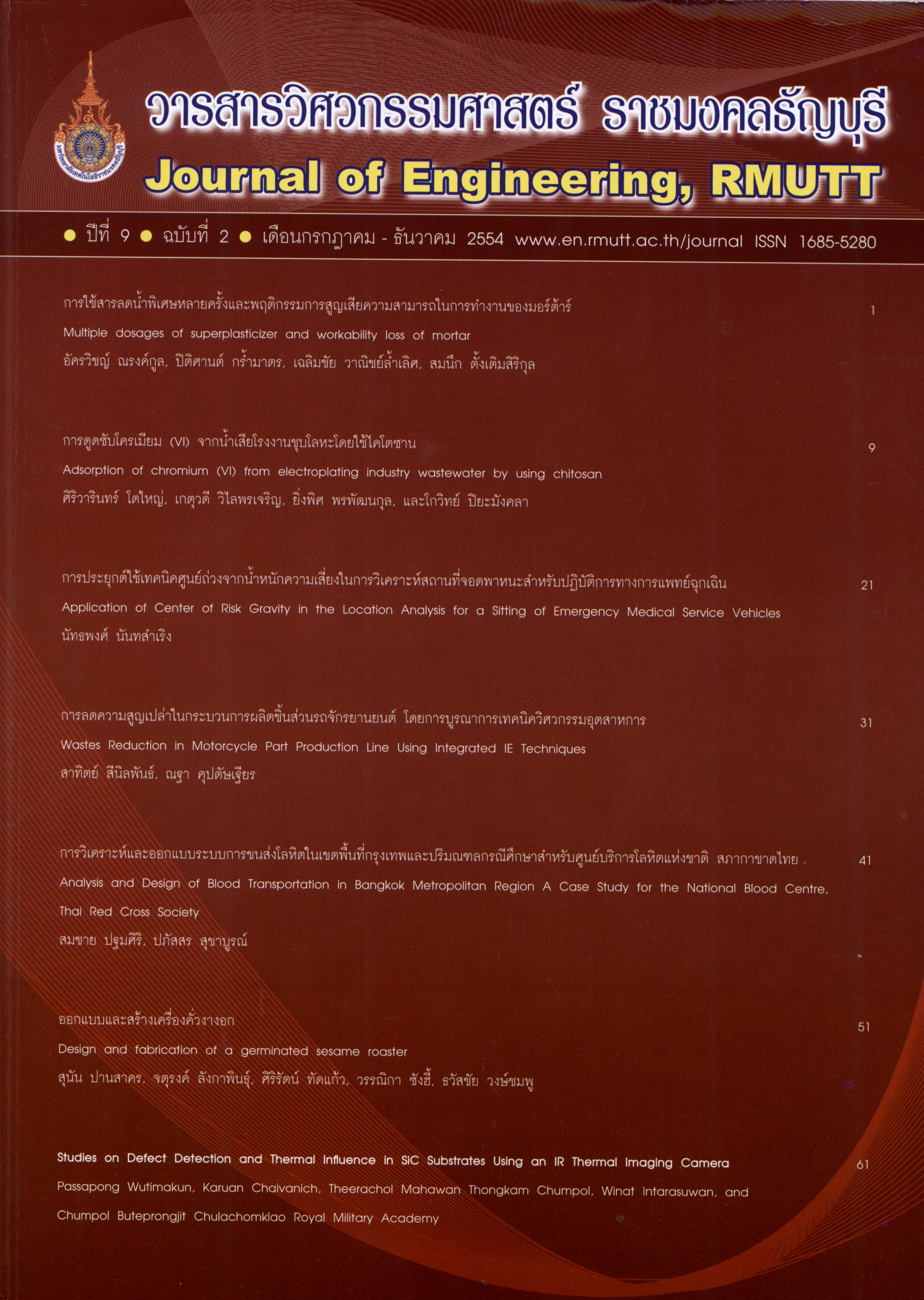การใช้สารลดน้ำพิเศษหลายครั้งและพฤติกรรมการสูญเสียความสามารถในการทำงานของมอร์ต้าร์
Main Article Content
บทคัดย่อ
งานวิจัยนี้มีจุดประสงค์เพื่อศึกษาผลของรูปแบบการใช้สารลดน้ำต่อพฤติกรรมการสูญเสียความสามารถในการทำงานของมอร์ต้าร์ ในการศึกษานี้ใช้ปูนซีเมนต์ปอร์ตแลนด์ประเภทที่ 1 เป็นวัสดุประสานเพียงชนิดเดียว ใช้สารลดน้ำพิเศษประเภทแนพทาลีนเป็นสารเคมีผสมเพิ่ม และทรายธรรมชาติเป็นมวลระเอียด ความสามารถในการทำงานของมอร์ต้าร์พิจารณาความในการเปลี่ยนรูปของมอร์ต้าร์ซึ่งวัดจากพื้นที่การไหลแผ่ผ่านอุปกรณ์ mini slump cone และความหนืดของมอร์ต้าร์ซึ่งวัดจากความเร็วในการไหลผ่านอุปกรณ์ V-Funnel สำหรับสัดส่วนผสมของมอร์ต้าร์นั้นมีอัตราส่วนปริมาตรซีเมนต์เพสต่อช่วงว่างระหว่างมวลรวมในทุกสัดส่วนผสมคงที่เท่ากับ 1.6 และมีการเปลี่ยนแปลงสัดส่วนผสม โดยมีอัตราส่วนน้ำต่อวัสดุประสาน (w/c) ระหว่าง 0.27-0.41 และปริมาตรสารลดน้ำพิเศษต่อวัสดุประสานระหว่างร้อยละ 0.5-2.5 โดยมีการใส่ลดน้ำหนักพิเศษ 2 รูปแบบคือ ใส่ครั้งเดียวตั้งแต่ต้น และใส่หลายครั้งที่เวลาต่างกันการสูญเสียความสามารถในการทำงานวัดจากความสามารถในการทำงานตั้งต้นและวัดต่อเนื่องทุก ครึ่งชั่วโมงไปจนกระทั่ง 2 ชั่วโมง ผลการศึกษาพบว่า กรณีใส่สารลดน้ำพิเศษครั้งเดียวเปรียบเทียบมอร์ต้าร์ที่มีพื้นที่การแผ่ตั้งต้นเท่ากัน มอร์ต้าร์ที่ใช้สารลดน้ำพิเศษมากกว่าจะมีความหนืดสูงกว่า และสูญเสียความสามารถในการเปลี่ยนรูปช้ากว่า กรณีที่ต้องการใช้งานมอร์ต้าร์เมื่อเวลาผ่านไปนานขึ้น รูปแบบการแบ่งเติมลดน้ำพิเศษหลายครั้ง จะทำให้มอร์ต้าร์ที่มีความสามารถในการทำงานดีกว่ารูปแบบการเติมสารลดน้ำพิเศษเพียงครั้งเดียว
Article Details
บทความ ข้อมูล เนื้อหา รูปภาพ ฯลฯ ที่ได้รับการตีพิมพ์ในวารสารแนวหน้าวิจัยนวัตกรรมทางวิศวกรรม ถือเป็นลิขสิทธิ์ของวารสารฯ เท่านั้น ไม่อนุญาติให้บุคคลหรือหน่วยงานใดคัดลอกเนื้อหาทั้งหมดหรือส่วนหนึ่งส่วนใดไปเผยแพร่เพื่อกระทำการใด ๆ ที่ไม่ถูกต้องตามหลักจริยธรรม
References
Hattori, Kenichi, Experiences with Mighty Super plasticizers in Japan, Proceedings of the 1st: CANMET/ACI Conference on Superplasticizers in concrete, Ottawa, Canada, V.M. Maalhotra,Editor, ACI SP-62, pp. 37-66, 1979.
Malhotra, V.M., Superplasticizers: Their Effect .e Fresh and Hardened Concrete; Chapter 10
Progress in Concrete Technology, CANMET Energy, Mines and Resources Canada, V.M Malhotra, Editor, pp. 367-420, 1980.
Vinit Chovichien, Effect of Remixing on the Compressive Strength of Concrete, Research
Report, Department of Civil Engineering, Chulalongkorn University, Bangkok, 1982.
Meyer, L.M., and Perenchio, W.F., Theory of concrete slump loss as related to the use of
chemical admixtures, Concrete International,Vol. 1, No. 1, pp. 36-43, 1979.
ปียะ ประสพสง, อำนวย พานิชกุลพงศ์ และ คมสัน มาลีสี, 25ร0. อิทธิพลของสารผสมเพิ่มที่มีผลต่อ
คุณสมบัติของคอนกรีตที่เบ่งน้ำออกเป็นสองส่วนการประชุมวิชาการวิศวกรรมโยธาแห่งชาติครั้งที่
, หน้า NCCE12-Volume 5 (MAT)-Page 99 - NCCF12- Volume 5 - Page 105.

